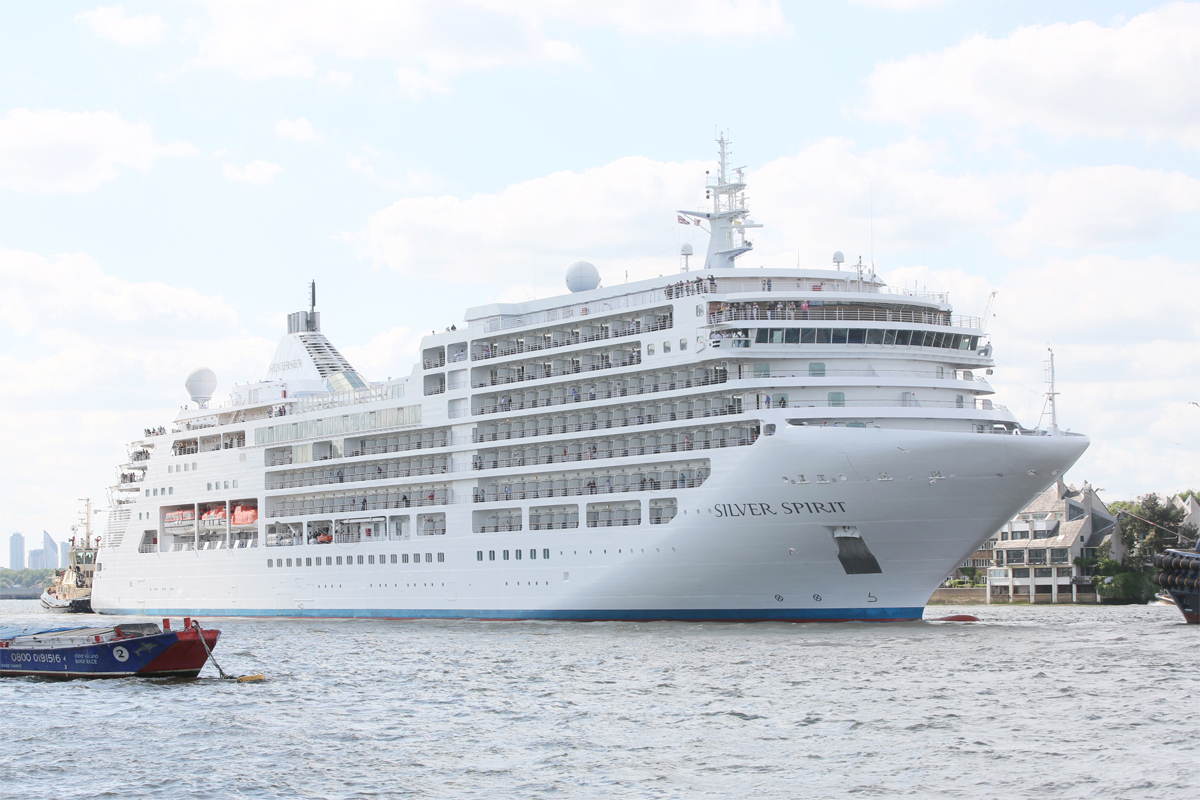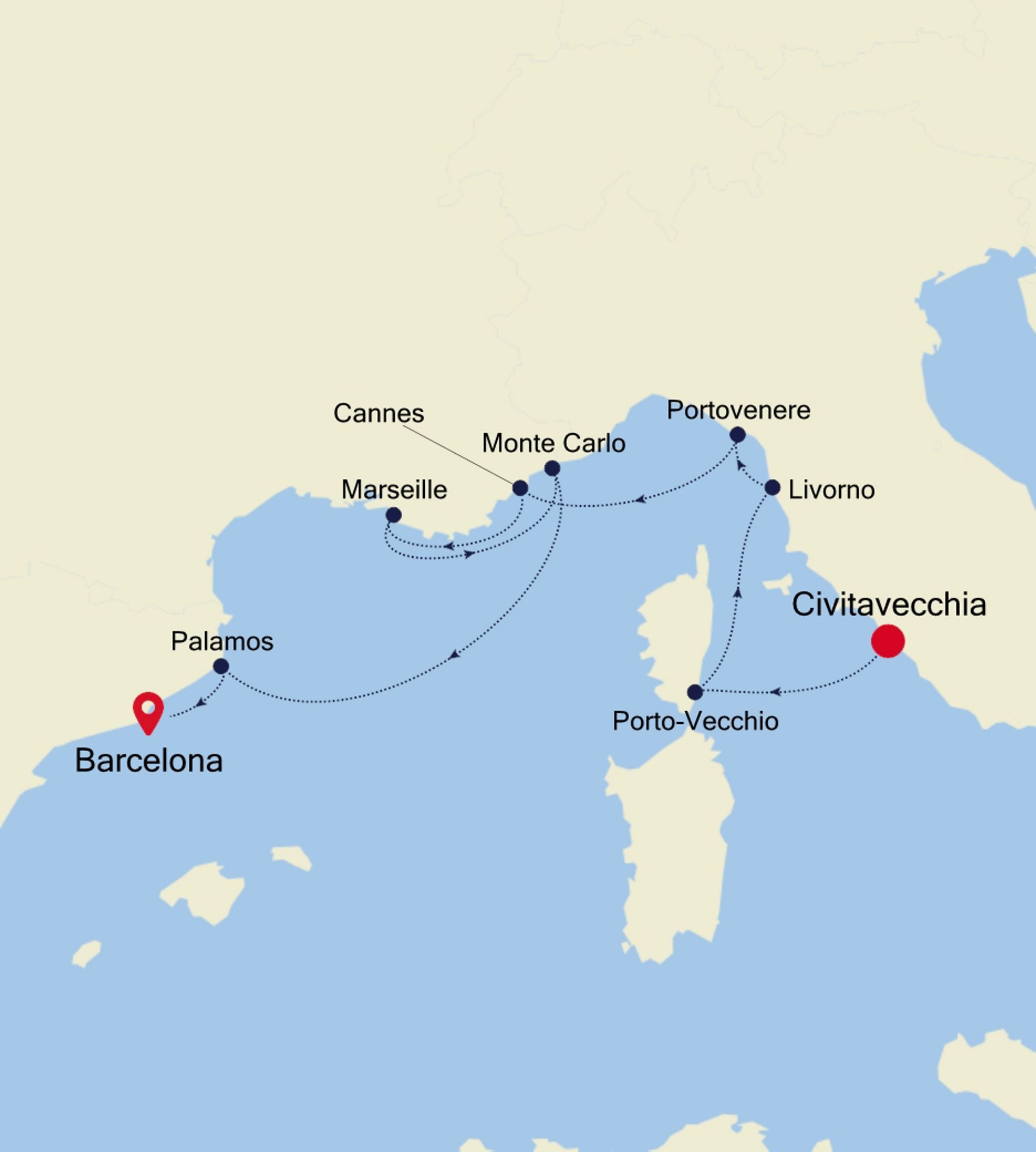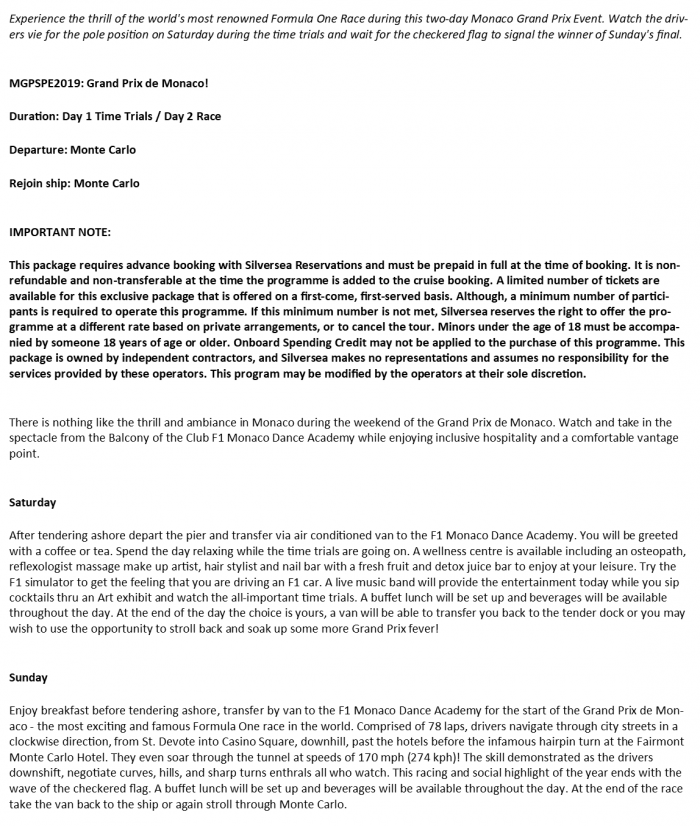2020 Monaco Grand Prix Silverseas, Monaco Formula 1 Race Package
Join us on this extraordinary 2020 Monaco Grand Prix Cruise aboard Silversea's Silver Spirit

Package code F1A20-07SS
Imagine the excitement building crescendo as you take center stage at not one but two glamourous world events. This is where the French Riviera really shines: with the bright lights of the Cannes Film Festival followed hot on the heels by the Monte-Carlo Grand Prix, there is simply no other place to be. From star spotting to casino hopping, don your best sunglasses to blend in like a local.The independent principality of Monaco is famous as the playground of the Côte d’Azur. With nice beaches, elegant hotels and a vibrant nightlife, this tiny domain is a favorite haunt of the jet set. In the possession of the Grimaldi family for more than 700 years, a treaty with France guarantees Monaco’s independence as long as the principality is governed by the Grimaldis.
ON-LINE RESERVATIONS ARE NOT CURRENTLY BEING TAKEN. PLEASE CALL US AT 800-782-8222 OR 912-233-3836 FOR INFORMATION OR TO MAKE A RESERVATION.
Proof of Citizenship is required: Passports are required. We will need your names as they appear on your passport and your birthdates for processing.
Rates start at $6600.00 per person plus taxes based on the suite location chosen. The Monte Carlo Grand Prix 2-Day Excursion is an additional shore excursion fare of between $3000-$3500 USD per person (price to be determined at later date by cruise line).
*Rates are per person, based on double occupancy, reflect all discounts and include non-discountable amounts. Taxes, Fees & Port Expenses are additional.
Vista Suite
A quiet sanctuary. The sitting area of the Vista Suite has plenty of room to relax. Large picture windows frame panoramic ocean views. The perfect backdrop for breakfast in bed during the cruise. Some Vista Suites accommodate three guests.
One bedroom: 312 ft² / 29 m²
Classic Veranda Suite
The Classic Veranda Suite provides generous living space for voyagers. Located lower bow, the Classic Veranda Suite offers all the comfort and attention to detail that you can expect aboard — both inside and out. A generous expanse of interior comforts — elegant décor, stunning marble bathroom and ample seating area, make this a cosy home away from home. But perhaps this suite’s finest asset lies just outside, as floor-to-ceiling glass doors open onto a private veranda, making every sunset feel as if it is yours alone.
Superior Veranda Suite
Located on the upper deck, and offering spectacular sunset views, the Superior Veranda Suite has all the comforts and luxury that you can expect aboard. A comfortable living space, attention to detail and a generous expanse of amenities, this stunning suite makes for a cosy home while on the seas. But perhaps this suite’s finest asset lies just outside, as floor-to-ceiling glass doors open onto a private veranda, making every sunset feel as if it is yours alone.
One bedroom: 376 ft² / 35 m² including veranda
Deluxe Veranda Suite
The Deluxe Veranda Suite offers a comfortable living space, close to the heart of the ship. With its preferred mid-ship location and all the comfort and attention to detail that you can expect aboard, the Deluxe Veranda Suite is the savvy traveller’s paradise— both inside and out. Elegant décor, stunning marble bathroom and ample seating area, make this a cosy home away from home. But perhaps this suite’s finest asset lies just outside, as floor-to-ceiling glass doors open onto a private veranda, making every sunset feel as if it is yours alone.
One bedroom: 376 ft² / 35 m² including veranda
Silver Suite
Step onto your terrace and bask in the calm feeling of the ocean breeze. Dissolve into the comfort of your king size bed. Prepare for the evening in the beautiful marble bathroom. The upper deck location gives the most spectacular of sea views, the spacious living area allows for comfortable relaxing where cosy nights in become veritable experiences in themselves. The two-bedroom configuration of this suite makes this it the ideal option for families.
Two bedroom: 1080 ft² / 100 m² including veranda

Click to Zoom
Monaco Grand Prix
The Monaco Grand Prix (French: Grand Prix de Monaco) is a Formula One motor race held each year on the Circuit de Monaco. Run since 1929, it is widely considered to be one of the most important and prestigious automobile races in the world, alongside the Indianapolis 500, and the 24 Hours of Le Mans. The circuit has been called "an exceptional location of glamour and prestige. The race is held on a narrow course laid out in the streets of Monaco, with many elevation changes and tight corners as well as a tunnel, making it one of the most demanding tracks in Formula One. In spite of the relatively low average speeds, it is a dangerous place to race. It is the only Grand Prix that does not adhere to the FIA's mandated 305 kilometres (190 mi) minimum race distance. The first race in 1929, was organised by Antony Noghès under the auspices of the "Automobile Club de Monaco", and was won by William Grover-Williams driving a Bugatti. The event was part of the pre-Second World War European Championship and was included in the first World Championship of Drivers in 1950. It was designated the European Grand Prix two times, 1955 and 1963, when this title was an honorary designation given each year to one Grand Prix race in Europe. Graham Hill was known as "Mr. Monaco"[2] due to his five Monaco wins in the 1960s. Brazil's Ayrton Senna won the race more times than any other driver, with six victories, winning five races consecutively between 1989 and 1993.

Click to Zoom
Silverseas Silver Spirit

Silverseas Silver Spirit
The all-new Silver Spirit has never looked better, nor felt cosier. Fully refurbished for a superlative onboard adventure, she retains our world famous standards of service and home away from home feel.
With one of the highest space to guest ratios in the business and eight superlative luxury dining options, Silver Spirit offers its guests one of the most complete cruise experiences available. Spacious decks leave plenty of room for relaxation, yet the cosy niches make sure that there is something for everyone. Meet like-minded friends; enjoy first class dining and relax in what is possibly the best place between sea and sky.
CAPACITY: 608 guests
LAST REFURBISHMENT: 2018
CREW: 411 international staff
| Date | Port | Arrive | Depart |
|---|---|---|---|
| Sunday, May 17 | Civitavecchia (Rome), Italy | 7:00 pm | |
| Monday, May 18 | Porto-Vecchio, France | 8:00 am | 6:00 pm |
| Tuesday, May 19 | Livorno (Tuscany), Italy | 8:00 am | 11:00 pm |
| Wednesday, May 20 | Portovenere (Cinqueterre), Italy | 8:00 am | 10:30 pm |
| Thursday, May 21 | Cannes, France | 8:00 am | 11:00 pm |
| Friday, May 22 | Marseille (Provence), France | 8:00 am | 7:00 pm |
| Saturday, May 23 | Monte Carlo (Grand Prix), Monaco | 8:00 am | |
| Sunday, May 24 | Monte Carlo (Grand Prix), Monaco | 10:30 pm | |
| Monday, May 25 | Palamos, Spain | 1:30 pm | 10:30 pm |
| Tuesday, May 26 | Barcelona, Spain | 8:00 am |

DAY 1 CIVITAVECCHIA (ROME), ITALY
Italy's vibrant capital lives in the present, but no other city on earth evokes its past so powerfully. For over 2,500 years, emperors, popes, artists, and common citizens have left their mark here. Archaeological remains from ancient Rome, art-stuffed churches, and the treasures of Vatican City vie for your attention, but Rome is also a wonderful place to practice the Italian-perfected il dolce far niente, the sweet art of idleness. Your most memorable experiences may include sitting at a caffè in the Campo de' Fiori or strolling in a beguiling piazza.
DAY 2 PORTO-VECCHIO, ITALY
Set on a hillock overlooking a beautiful deep blue bay, Porto Vecchio, 15 miles (25km) north of Bonifacio, was rated by Scottish author James Boswell as one of "the most distinguished harbours in Europe". It was founded in 1539 as a second Genoese stronghold on the east coast, Bastia being well established in the north. The site was perfect; close to the unexploited and fertile plain, it benefited from secure high land and a sheltered harbour, although the mosquito population spread malaria and wiped out the first Ligurian settlers within months. Things began to take off mainly thanks to the cork industry, which still thrived well into the twentieth century. Today, a third of Corsica's wine is exported from Porto Vecchio, but most revenue comes from visitors. Around the centre of town explore the well-preserved fortress and the small grid of ancient streets backing onto the main place de la République. East of the square you can't miss the Porte Génoise, which frames a delightful expanse of sea and salt pans and through which you'll find the quickest route down to the modern marina, lined with cafés and hotels.
DAY 3 LIVORNO (TUSCANY), ITALY
Livorno is a gritty city with a long and interesting history. In the early Middle Ages it alternately belonged to Pisa and Genoa. In 1421 Florence, seeking access to the sea, bought it. Cosimo I (1519–74) started construction of the harbor in 1571, putting Livorno on the map. After Ferdinando I de' Medici (1549–1609) proclaimed Livorno a free city, it became a haven for people suffering from religious persecution; Roman Catholics from England and Jews and Moors from Spain and Portugal, among others, settled here. The Quattro Mori (Four Moors), also known as the Monument to Ferdinando I, commemorates this. (The statue of Ferdinando I dates from 1595, the bronze Moors by Pietro Tacca from the 1620s.) In the following centuries, and particularly in the 18th, Livorno boomed as a port. In the 19th century the town drew a host of famous Britons passing through on their grand tours. Its prominence continued up to World War II, when it was heavily bombed. Much of the town's architecture, therefore, postdates the war, and it's somewhat difficult to imagine what it might have looked like before. Livorno has recovered from the war, however, as it's become a huge point of departure for container ships, as well as the only spot in Tuscany for cruise ships to dock for the day. Most of Livorno's artistic treasures date from the 17th century and aren't all that interesting unless you dote on obscure baroque artists. Livorno's most famous native artist, Amedeo Modigliani (1884–1920), was of much more recent vintage. Sadly, there's no notable work by him in his hometown. There may not be much in the way of art, but it's still worth strolling around the city. The Mercato Nuovo, which has been around since 1894, sells all sorts of fruits, vegetables, grains, meat, and fish. Outdoor markets nearby are also chock-full of local color. The presence of Camp Darby, an American military base just outside town, accounts for the availability of many American products. If you have time, Livorno is worth a stop for lunch or dinner at the very least.
DAY 4 PORTOVENERE (CINQUETERRE), ITALY
The colorful facades and pedestrians-only calata (promenade) make Portovenere the quintessential Ligurian seaside village. As a UNESCO World Heritage Site, its harbor is lined with tall, thin "terratetto" houses that date from as far back as the 11th century and are connected in a wall-like formation to protect against attacks by the Pisans and local pirates. Its tiny, carruggi (alley-like passageways) lead to an array of charming shops, homes, and gardens and eventually to the village's impressive Castle Doria high on the olive tree covered hill. To the west standing guard over the Mediterranean is the picturesque medieval Chiesa di San Pietro, once the site of a temple to Venus (Venere in Italian), from which Portovenere gets its name. Nearby, in a rocky area leading to the sea, is Byron's Cave, a favorite spot that the poet loved to swim out into the sea from.
DAY 5 CANNES, FRANCE
Cannes is pampered with the luxurious year-round climate that has made it one of the most popular resorts in Europe. Settled first by the Ligurians and then dubbed Cannoïs by the Romans (after the cane that waved in its marshes), Cannes was an important sentinel site for the monks who established themselves on Île St-Honorat in the Middle Ages. Its bay served as nothing more than a fishing port until in 1834 an English aristocrat, Lord Brougham, fell in love with the site during an emergency stopover with a sick daughter. He had a home built here and returned every winter for a sun cure—a ritual quickly picked up by his peers. Between the popularity of Le Train Blue transporting wealthy passengers from Calais, and the introduction in 1936 of France's first paid holidays, Cannes became the destination, a tasteful and expensive breeding ground for the upper-upscale. Cannes has been further glamorized by the ongoing success of its annual film festival, as famous as (and, in the trade, more respected than) Hollywood's Academy Awards. About the closest many of us will get to feeling like a film star is a stroll here along La Croisette, the iconic promenade that gracefully curves the wave-washed sand coastline, peppered with chic restaurants and prestigious private beaches. This is precisely the sort of place for which the French invented the verb flâner (to dawdle, saunter): strewn with palm trees and poseurs, its fancy boutiques and status-symbol grand hotels—including the Carlton, the legendary backdrop to Grace Kelly in To Catch a Thief —all vying for the custom of the Louis Vuitton set. This legend is, to many, the heart and soul of the Côte d'Azur, although don't expect a warm welcome: Cannes came 10th in Condé Nast's World's Unfriendliest Cities 2015.
DAY 6 MARSEILLE (PROVENCE), FRANCE
Since being designated a European Capital of Culture for 2013, with an estimated €660 million of funding in the bargain, Marseille has been in the throes of an extraordinary transformation, with no fewer than five major new arts centers, a beautifully refurbished port, revitalized neighborhoods, and a slew of new shops and restaurants. Once the underdog, this time-burnished city is now welcoming an influx of weekend tourists who have colonized entire neighborhoods and transformed them into elegant pieds-à-terre (or should we say, mer). The second-largest city in France, Marseille is one of Europe's most vibrant destinations. Feisty and fond of broad gestures, it is also as complicated and as cosmopolitan now as it was when a band of Phoenician Greeks first sailed into the harbor that is today's Vieux Port in 600 BC. Legend has it that on that same day a local chieftain's daughter, Gyptis, needed to choose a husband, and her wandering eyes settled on the Greeks' handsome commander Protis. Her dowry brought land near the mouth of the Rhône, where the Greeks founded Massalia, the most important Continental shipping port in antiquity. The port flourished for some 500 years as a typical Greek city, enjoying the full flush of classical culture, its gods, its democratic political system, its sports and theater, and its naval prowess. Caesar changed all that, besieging the city in 49 BC and seizing most of its colonies. In 1214 Marseille was seized again, this time by Charles d'Anjou, and was later annexed to France by Henri IV in 1481, but it was not until Louis XIV took the throne that the biggest transformations of the port began; he pulled down the city walls in 1666 and expanded the port to the Rive Neuve (New Riverbank). The city was devastated by plague in 1720, losing more than half its population. By the time of the Revolution, Marseille was on the rebound once again, with industries of soap manufacturing and oil processing flourishing, encouraging a wave of immigration from Provence and Italy. With the opening of the Suez Canal in 1869, Marseille became the greatest boomtown in 19th-century Europe. With a large influx of immigrants from areas as exotic as Tangiers, the city quickly acquired the multicultural population it maintains to this day.
DAY 7 MONTE CARLO (GRAND PRIX), FRANCE
The independent principality of Monaco is famous as the playground of the Côte d’Azur. With nice beaches, elegant hotels and a vibrant nightlife, this tiny domain is a favorite haunt of the jet set. In the possession of the Grimaldi family for more than 700 years, a treaty with France guarantees Monaco’s independence as long as the principality is governed by the Grimaldis. The fashionable enclave numbers only about 32,000 inhabitants and is smaller than New York’s Central Park, but it boasts some of the most expensive real estate in the world. In addition to its luxury hotels and beautiful beaches, Monaco is noted for its mild climate and magnificent scenery. Once an exclusive wintering stop for Europe’s aristocracy, today there are more than five million visitors annually. Of the principality’s four sections - La Condamine, Fontvieille, Monaco-Ville and Monte Carlo, the latter two rank highest on every visitor’s must-see list. In Monte Carlo, the Grand Casino is perhaps Monaco's most outstanding attraction. For more than a century, the principality's livelihood was centered beneath the copper roof of this splendid establishment. The resemblance to the Paris Opera House is less than accidental since they share the same architect, Charles Garnier. Also facing the square are the famed Hotel de Paris and the more modest Café de Paris. Excursions to the F1 Circuit at Monaco are available. Limited quantities, reserve early.
DAY 8 MONTE CARLO (GRAND PRIX), FRANCE
The independent principality of Monaco is famous as the playground of the Côte d’Azur. With nice beaches, elegant hotels and a vibrant nightlife, this tiny domain is a favorite haunt of the jet set. In the possession of the Grimaldi family for more than 700 years, a treaty with France guarantees Monaco’s independence as long as the principality is governed by the Grimaldis. The fashionable enclave numbers only about 32,000 inhabitants and is smaller than New York’s Central Park, but it boasts some of the most expensive real estate in the world. In addition to its luxury hotels and beautiful beaches, Monaco is noted for its mild climate and magnificent scenery. Once an exclusive wintering stop for Europe’s aristocracy, today there are more than five million visitors annually. Of the principality’s four sections - La Condamine, Fontvieille, Monaco-Ville and Monte Carlo, the latter two rank highest on every visitor’s must-see list. In Monte Carlo, the Grand Casino is perhaps Monaco's most outstanding attraction. For more than a century, the principality's livelihood was centered beneath the copper roof of this splendid establishment. The resemblance to the Paris Opera House is less than accidental since they share the same architect, Charles Garnier. Also facing the square are the famed Hotel de Paris and the more modest Café de Paris. Excursions to the F1 Circuit at Monaco for the Monaco Grand Prix Race. Limited quantities, reserve early.
DAY 8 PALAMOS, SPAIN
One of the best ways to arrive in Catalonia is by sea, especially via the Costa Brava. This coastline, also known as the Rugged or Wild Coast, stretches from Blanes to the French border. Its name aptly refers to the steep cliff of ancient twisted rocks, which runs its entire length and is bounded inland by the Catalan mountain ranges. The intensity of the coast’s colour, the ruggedness of the rocks and the scent of the plants all combine to add to its attraction. The history of this region is long and varied. Traces can be found of the advanced culture of the Iberians, Greeks, Romans, Visigoths and Arabs. With Wilfred I and the independence of Catalan countries, the Catalan dynasty was born. Later, in 1479, Catalonia became a part of unified Spain following the marriage of Isabel, Queen of Castile, and Fernando, King of Aragon. The port of Palamos, some 36 miles northeast of Barcelona, has been in existence for nearly 700 years thanks to its location on one of the deepest natural bays in the western Mediterranean. The town itself is the southernmost of a series of resorts popular with sun worshippers. For the most part, Palamos has managed to retain some of the charm of a fishing village. The port also serves as a gateway to such inland locations as Girona, the capital of the province. Art lovers may want to visit Figueras, famous for its bizarre Teatre-Museu Dali, the foremost of a series of sites associated with the eccentric surrealist artist, Salvador Dali. If you choose to stay in Palamos, you can enjoy the pleasant atmosphere of the town or spend some time at a nearby beach. The town has a long seagoing tradition and busy harbour. The fish auction, prompted by the arrival of the fishing boats, is a spectacle worth seeing. The Fishing Museum illustrates the history and the life of the families who live off the sea.
DAY 9 BARCELONA, SPAIN
The infinite variety of street life, the nooks and crannies of the medieval Barri Gòtic, the ceramic tile and stained glass of Art Nouveau facades, the art and music, the throb of street life, the food (ah, the food!)—one way or another, Barcelona will find a way to get your full attention. The capital of Catalonia is a banquet for the senses, with its beguiling mix of ancient and modern architecture, tempting cafés and markets, and sun-drenched Mediterranean beaches. A stroll along La Rambla and through waterfront Barceloneta, as well as a tour of Gaudí's majestic Sagrada Famíliaand his other unique creations, are part of a visit to Spain's second-largest city. Modern art museums and chic shops call for attention, too. Barcelona's vibe stays lively well into the night, when you can linger over regional wine and cuisine at buzzing tapas bars.
The Sample Itinerary below is from 2019 Monaco Grand Prix (2020 itinerary is subject to change):




